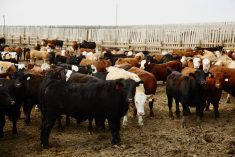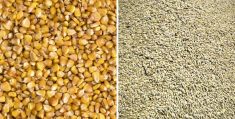The December live cattle futures made a low of $173.50 on September 9. At the time of writing this article, the December contract was $189. During September and October, the live cattle futures rallied about $16. In the U.S., the four largest packing firms handle 85 per cent of all steer and heifer purchases. Apparently, about 22 beef plants handle 75 per cent of the total slaughter. This is considered a mature market given the concentration of players. Often, producers will complain that it’s too concentrated but cattle producers can also use this to their advantage. We know when the packer or the commercial trader has very little coverage in the cash market and when this player has significant coverage. It’s called the Commitments of Traders Report.
Who is long and who is short is the most vital piece of information when trading or planning your hedging or risk management strategy. To make an analogy, when a grain elevator with a capacity of 200,000 tonnes is filled with 195,000 tonnes, we can say the elevator is full. When this occurs, the basis widens out and the grain futures spread moves to full carry. Conversely, when the elevator only has 10,000 tonnes, it’s relatively empty. There is more pressure on the elevator to buy grain when there are three, 100-unit trains scheduled to load in the next week. A packer manages their ownership position of live cattle similarly.

Included in this article we have the commercial short position from the Disaggregated Commitments of Traders Report each week from June 6, 2023, to October 15, 2024 (see above). This is considered the position of the packers. When the short position is at 150,000 contracts, we say the packer is full. This is similar to the 200,000-tonne elevator filled with 195,000 tonnes. When the position is at -80,000 contracts, this is similar to a 200,000-tonne elevator with ownership of only 5,000 tonnes and three unit trains to load in the next week. The live cattle futures have strong commercial support when the commercial position is nearing -80,000 contracts. In most cases, the live cattle futures will trend higher when the commercial position is at this level.
I’ve talked about the Commitments of Traders before but I want to take this a step further. The USDA releases the Cattle-on-Feed Report each month. Most analysts just look at the first page for the total number of cattle on feed. However, the most important information from this report is on the fifth page, where the USDA shows how many cattle are placed each month in each weight category.

We can use this information to project how many market-ready supplies of steers and heifers will be available for any given month. In our example, I’ve shown the U.S. feedlot placements from February through July 2024 (see above). To project the market-ready supplies of steers and heifers for the month of October, we start with the February placements under 600 lb., which were up 15,000 head from February 2023. Onto this number, we add the March placements in the 600-699-lb. category which were down 55,000 head from last year. We continue to add the year-over-year change in the subsequent weight category for the next month. Onto this total of 40,000 head, we would add the year-over-year change of -35,000 head in the 700-799-lb. category during April. Using this information, we know that market-ready supplies during the month of October will be down 71,000 head from last year. The August 1 Cattle-on-Feed Report came out on August 23. At the end of August 2024, we know that the U.S. packer has little coverage in the cash market. We also know that market-ready supplies of steers and heifers during October will be down 71,000 head from October 2023. We can say that there was significant open demand and market-ready steer and heifer supplies are down sharply from last year.
On the flip side, back in September 2023, the commercial short position was near -140,000 head. At that time, the U.S. packer had significant coverage, and market-ready supplies for October 2023 were actually above October 2022. During the fall of 2023, the live cattle futures were trending lower.
Read Also

The Canadian Cattle Association’s international advocacy efforts
Global ag policies affect Canadian food policy, so the Canadian Cattle Association participates in international and domestic forums
For finishing feedlots, balancing the market-ready supplies of steers and heifers with the commercial position on the Commitment of Traders is vital for deciding when to forward contract or contract on basis. In our example, we knew in September that the U.S. packer had little coverage in the cash market and there was a year-over-year decrease in market-ready supplies for October. Stronger demand and lower supplies result in a higher price. Thus we see the futures rallying $16. For cow-calf producers, this information can be extremely helpful when determining the timing for marketing your calves or backgrounded cattle.
















